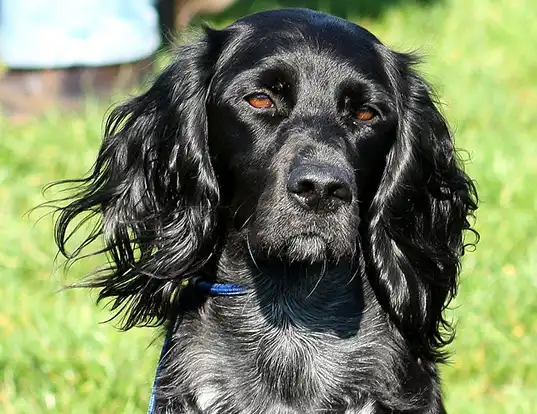Other names: Épagneul Bleu de Picardie
Common nicknames: Bleu Picard
Origin: France
Kennel club standards:
Société Centrale Canine standard
Fédération Cynologique Internationale standard
Dog (domestic dog)
The Blue Picardy Spaniel, also known as Épagneul Bleu de Picardie, hails from the picturesque landscapes of France, specifically from the region surrounding the River Somme's mouth. Emerging in the early 20th century, this breed is a fascinating blend of Picardy Spaniels and English Setters. It's renowned for its tranquil demeanor, coupled with an extraordinary need for exercise, thanks to its boundless stamina. This breed is particularly cherished for its compatibility with children. Much like its relative, the Picardy Spaniel, it boasts a unique coat coloration. Though its recognition is limited to a few kennel clubs, the Blue Picardy Spaniel enjoys notable popularity in France and Canada.
Description
Appearance
Typically, a Blue Picardy Spaniel stands between 22 to 24 inches (56 to 61 cm) tall at the withers, with a weight hovering around 43 to 45 pounds (20 to 21 kg). Its coat, a mesmerizing speckled grey-black, often appears bluish, adorned with occasional black patches. The texture is either flat or slightly wavy, with feathering gracing the ears, legs, underside, and tail. The breed's physique is defined by robust, muscular legs, and a long, broad muzzle. Its ears, covered in silky hair, usually extend to the muzzle's tip. The chest is of moderate size, aligning with the elbows, and both the forequarters and hindquarters are well-muscled. The tail, typically straight, does not extend beyond the hock.
Resembling the Picardy Spaniel due to their shared lineage, the Blue Picardy Spaniel is noted for its softer disposition and distinctive coat color—black and grey, thanks to the infusion of English Setter blood. In contrast, the Picardy Spaniel sports a brown coat. This subtle yet significant difference, alongside their close breed standards, sets them apart in the modern era.
Temperament
Quiet yet energetic, the Blue Picardy Spaniel demands ample exercise to match its high stamina. Playful and obedient, this breed thrives on human companionship and is particularly good with children. Its responsive nature makes it a delightful family dog.
History
At the dawn of the 20th century, the area near the River Somme's mouth was a haven for hunters pursuing wildfowl. Due to strict quarantine regulations in the United Kingdom, British hunters would lodge their dogs in the Picardy region. This practice led to the mingling of English Setter blood with local Spaniels, giving rise to the Blue Picardy Spaniel.
The first documented black, blue-grey Spaniel dates back to 1875. However, it wasn't until 1904 that the Picardy Spaniel made its debut at the Paris Canine Exposition, classified then as a French Spaniel. The Picard Spaniel and Blue Picardy Spaniel Club, established in 1907, distinguished the two breeds. By 1938, France officially recognized the Blue Picardy as a separate breed.
Ronald Meunier of Saint-Julien, Quebec, was the first to import the Blue Picardy Spaniel into Canada around 1987. The Canadian Kennel Club acknowledged the breed on June 1, 1995.


Comments
Post a Comment